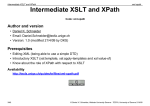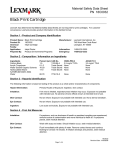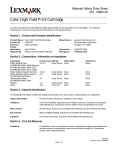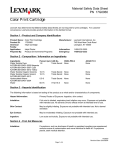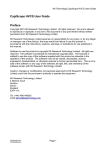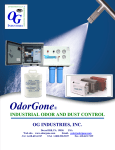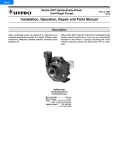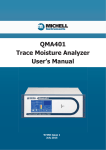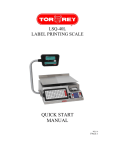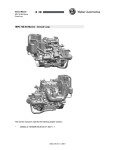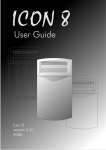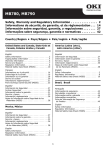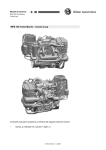Download How To- Mazda3 Coolant Drain + Refill
Transcript
Mazda3 Coolant Drain / Refill At 32K miles, my coolant is no longer bright green, but dark green. I decided that I’d drain and refill about a gallon of coolant in my car for good measure. Keep in mind that this method only changes “part” of the total coolant in your car. I decided to use ZEREX by Valvoline G-05 coolant – (A Ford and Chrysler coolant). The color of this coolant is still green, though a lighter almost yellowish green color. Since this coolant appears to be compatible with FL22 (Just like Peak Global Extended Life), I decided to buy it for like $11. You can pay extra for those extended life coolants, though I would still want to flush the coolant every 2 years or so. It's a small price to pay compared to fixing damages done by erosion and corrosion. Here’s how I did the drain and refill, I added notes from the Factory Service Manual, which is by MAZDA: Warning: • Never remove the cooling system cap or loosen the radiator drain plug while the engine is running, or when the engine and radiator are hot. Scalding engine coolant and steam may shoot out and cause serious injury. It may also damage the engine and cooling system. • Turn off the engine and wait until it is cool. Even then, be very careful when removing the cap. Wrap a thick cloth around it and slowly turn it counter clockwise 2.5 turns. Step back while the pressure escapes. • When you are sure all the pressure is gone, turn the cap using the cloth, and remove it. Quote Caution:• Use engine coolant at the concentration that meets the environmental conditions in which the vehicle is driven, otherwise engine damage may occur • The engine has aluminum parts and must be protected by an ethelyne-glycol based coolant to prevent corrosion and freezing. • Do not use coolants containing alcohol, methanol, borate or silicate. These coolants could damage the cooling sys. • Use only soft (demineralized) water in the coolant mixture. Water that contains minerals will cut down the coolant's effectiveness. • Engine coolant damages paint. If engine coolant gets on the paint, rinse it off quickly. 1. Take off black plastic skid plate that you normally remove when doing an oil change. 2. Make sure the engine is COOL so the radiator is not under pressure to avoid burns. 3. Unscrew the cap from the pressurized plastic coolant reservoir on the left side of the engine bay. If the engine is still slightly warm, you might hear a “hiss” of pressurized gas escape. Unscrewing this cap allows “air” into the system for coolant to drain at the drain plug. 4. Locate the black plastic drain plug on the bottom of the radiator, and unscrew it using a short wide flathead screw driver (Or short, wide head Phillips screw driver). 5. Once it’s unscrewed, there’s still a portion of the drain plug preventing fluid from draining, You have to pry at the plug a little and pull it straight out enough so that the fluid drains. 6. Cold or warm coolant should then be coming out of the radiator drain plug. Catch this in a container that can hold more than a gallon. (Optional to pour distilled (demineralized) water into the reservoir to "flush" some old fluid out until the water exiting the drain plug is clean and clear). 7. As the coolant drains you will see your coolant reservoir level drop. This is where you fill re-fill your car with new coolant. 8. Once coolant is drained, retighten drain plug snug by hand (firm, don’t over tighten or strip the plastic head) 9. I used a 50/50 distilled water to anti-freeze ratio. Engine coolant protection: volume percentage (% water / % coolant); specific gravity at 68-degF • above 3 degF; (65 / 35); 1.057 • above -15 degF; ( 55 / 45 ); 1.072 • above -40 degF; ( 45 / 55 ); 1.086 • (50/50 ratio may yield about -27.5 degF) 10. Total coolant drained was exactly 36,900 ml in my car. Or 3.7 liters (0.98 gallons) This may vary depending on how full your reservoir is at the time you drain your coolant. I know I didn’t let ALL of the coolant drain from the radiator, though I did let a majority of the coolant drain. I believe the car uses almost 2 gallons of coolant total so you will be replacing about half of the total capacity. 11. What I did next was then fill up one 0.5L (1 pint) water bottle with distilled water, and another bottle with coolant. Then I poured these into the reservoir. I repeated this process until it was about a gallon (same amount of coolant removed). 12. As a precaution, when done you may warm up the engine to operating temperature with the coolant cap off the reservoir. This may take 5 minutes or possible longer. When the engine is at operating temperature the coolant will be cycling. Then you should give throttle and this should help remove any possible air bubbles in the cooling system. Screw the coolant cap back on the reservoir. After a few cooling cycles you should re-check your coolant levels and top off your fluids if necessary. The following steps A-C describe this in detail though I believe this to be a bit excessive: A. Start the engine and idle it until the water temp indicator is in the center when the engine is below 1500rpm. B. Bleed the air from the cooling system by using the procedures below. At this time, monitor the coolant temp to prevent overheating. • Run the engine at 2500rpm for 2-3 minutes, 2 times. • Run the engine at 3000rpm for 5 seconds, then idle. • Repeat steps above twice. C. Stop engine and inspect coolant level after the coolant cools down. 13. For disposal, depending on local laws, you might be able to dump it in your sanitary sewer system (toilet), or you may have to take it to a nearby hazardous waste collection facility. (1-800-cleanup). Just don’t dump it into the gutter. Coolant FAQ: What about air bubbles/air bleeding issues? This method did not introduce any bubbles or cause any issues that would require special air-bleeding. This is because all you are doing is draining the radiator and reservoir, and then re-filling it up. Coolant inside the engine block remains untouched and thus this method does not change ALL of the fluid. To change the coolant in your entire vehicle I highly recommend you take it to a certified Mazda dealer. (Or a mechanic well knowledged in how to do an air bleed correctly on a Mazda3) What is FL22 and what does Mazda say about FL22? FL22 is a coolant type that may be in your Mazda. (though it was not in my car) It should specify on the coolant cap whether or not your car has FL22. If it doesn't specify, then any "green" coolant should work. FL22 is used to enhance service life, reduce waste material, and lower maintenance costs, and adds convenience being pre-mixed. It is recommended that FL22 coolant continue to be used for models originally filled with FL22 coolant from the factory. FL22 is by Motorcraft and is avialable at most Mazda Dealerships though I just use Peak Global Lifetime from Wal-mart. CAUTION: FL22 coolant is “pre-mixed” and must be added to the cooling system as is. DO NOT ADD WATER TO FL22 COOLANT. Adding water will dilute the solution and lessen the effectiveness of the coolant. If coolant replacement becomes necessary for prior Mazda models (not originally filled with FL22 coolant), FL22 coolant can be used. If FL22 coolant is used for prior models, be sure to place the FL22 sticker on the reserve tank or degas bottle to indicate FL22 coolant is being used. NOTE: • In the case of prior models, the coolant replacement interval is every five (5) years or 60,000 miles (96,000 km). • Six (6) FL22 stickers are included with each case of coolant. What does FL22 say on the bottle? Ethylene glycol based 55/45 mixture recommended Developed to provide corrosion and rust protection Boiling point 270 degrees Freezing point -47 degrees Ingrediants: Ethylene Glycol (107-21-1) Water (7732-18-5) Diethylene Glycol (111-46-6) Potassium Hydroxide (1310-58-3) Proprietary Inhibitors (NJTSRN 217). "DO NOT USE coolants containing: Alcohol, methanol, borate, or silicates" What does the manual say about coolant replacement? FL22 120,000miles or 10 years Others 60,000miles or 4 years Who really makes FL22? Old World Industries (the makers of Peak, Sierra, and other antifreeze brands) state that FL-22 is a Motorcraft extended life coolant and that either Peak Global Lifetime or Peak LongLife Antifreeze can be added to FL-22 without issue. Both of those are silicate free, and LongLife is also phosphate free. What coolant do I need for my Mazda3? Any modern coolant that is silicate/phosphate free which is a majority of the green coolants on the market. When you view the ingredients of FL22, there's nothing really special. Just make sure you do not exceed 60% antifreeze as a part of your solution. (Per the service manual) How much coolant do I need if I drain the radiator and fill it up myself? About 1 Gallon of premix, or half gallon of antifreeze + half gallon of distilled water (If you mix your own). Why not go to the dealer for a flush, How much will it cost? If you get your car’s cooling system flushed at a dealer or mechanic, they will flush all of the coolant. My Irvine Mazda dealer quoted $110, but that was with a coupon. So it could be higher or lower depending on your dealer. I believe this dealer flush should be done before 60k miles. I might get mine done at 40k miles... Now Mazda may state to change the coolant at 100k miles or the coolant may be a special long life formula, but I'd feel much safer changing the coolant every 2 years or so. The main reason is because of the metals in the cooling system that "erode" into the coolant. (Erosion, Electrolysis, corrosion, rust, etc). DISCLAIMER - I take no responsibility if you forget something, there's a coolant leak, and you blow an engine etc... Work on your car at your own risk.








